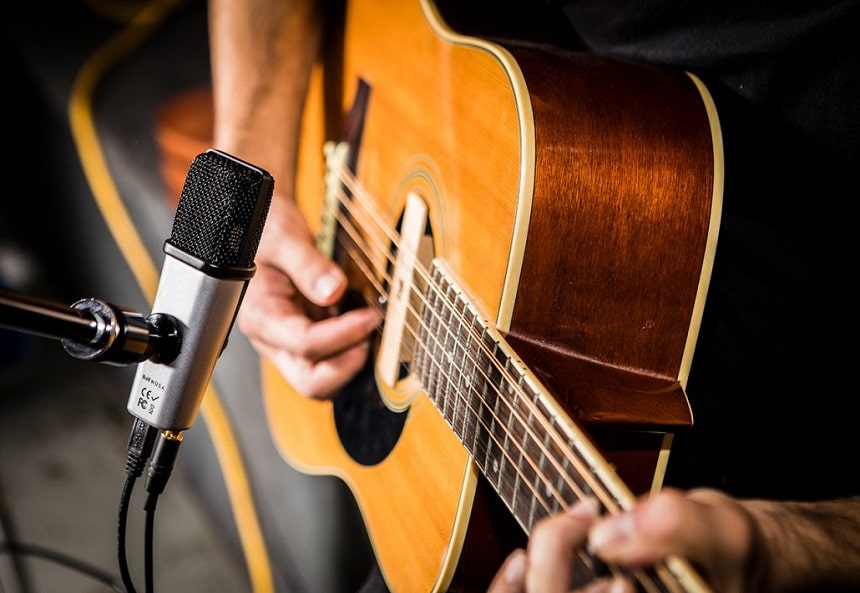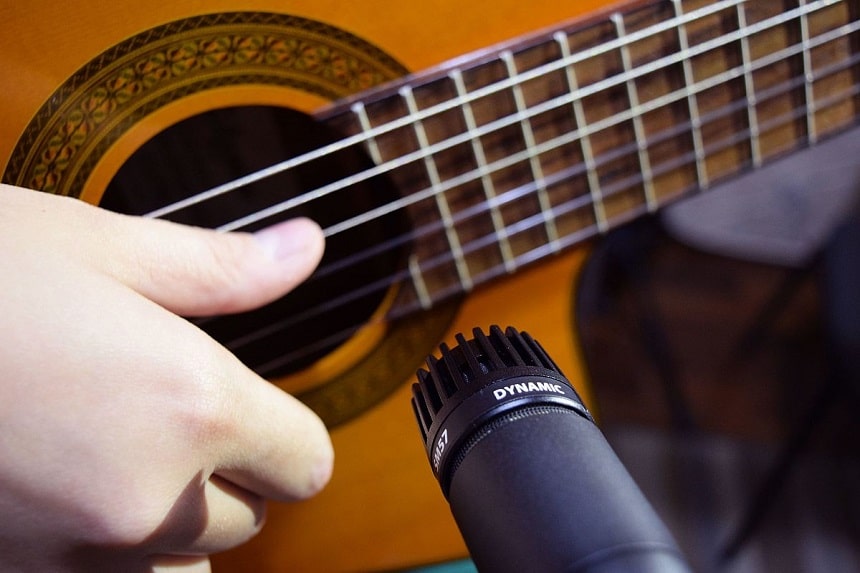Acoustic guitars might be associated with country music, but these instruments are so versatile that you can find them in different music genres. If you play the guitar, you certainly want to capture excellent sound. However, what constitutes excellent sound is rather subjective and depends on your preference. There are numerous ways to record an acoustic guitar, but a fundamental requirement is to know how to mic an acoustic guitar Trusted Source Acoustic guitar - Wikipedia An acoustic guitar is a musical instrument in the string family. When a string is plucked its vibration is transmitted from the bridge, resonating throughout the top of the guitar. It is also transmitted to the side and back of the instrument, resonating through the air in the body, finally producing sound from the sound hole. en.wikipedia.org .
The ability to mic the acoustic guitar can be relatively difficult if you don’t know what you are doing. That is why despite the appeal of this instrument, many home-recorded tracks fail to impress listeners. So, in this post, we will teach you how to mic the guitar. In this post, we will consider the adjustments that you need to know how to make so that your recording turns out really well. In the end, you will know exactly how to successfully mic the guitar.

When you are looking to mic the guitar, it might look like a hard task, and this is not even limited to only acoustic guitars. The problem of recording an acoustic instrument has plagued many musicians. However, with the tips that we will provide in this article, you will find out the best ways to enjoy the sound of your guitar.
Before you even start recording anything, you must ensure that you realize the effect of the space on the sound of your instrument. The recorded sound is affected by several factors. Some of the most important considerations are the shape of the room and the sound of the room.
So, what should you keep in mind? Acoustics. You should keep in mind that if the room or space to be used has plenty of hard surfaces, there will be plenty of sound reflection. This will expand the sound, giving it a roomy and characterful sound. It will certainly sound great when done right, but due to the expansiveness, it can be hard to control.
On the other hand, if you are making music in a room with soft surfaces, for instance, your bedroom, the furniture, and soft surfaces will absorb the sound and make it tighter.
If you want to mic a guitar or any instrument for that matter, you have to know the right type of microphone to use. There are two main types of microphones – condenser and dynamic microphones.
Acoustic guitars are some of the most delicate instruments and have plenty of hi-fi information. Therefore, we recommend that you go for condenser microphones. While that is our recommendation, it is by no means set in stone. You can test out different microphones to see the one that will serve you the best. Check our article about the best ribbon mics to learn more and find a suitable pick.
Apart from the type of microphone used, you also need to determine whether you will record in mono or in stereo. If you are recording in mono, this means that you are recording with a single microphone. Stereo recording means that you are using two microphones.
Before choosing either of the recording methods, there are some things that you should keep in mind.
Stereo Recording
Another thing to consider when micing an acoustic guitar is the attributes of the guitar. You have to consider stuff like tuning. Also, you should also look at other factors like the weight of the strings, the way the strings feel on your fingers, and so on. If the strings are light, then you should expect a bright, cheery sound. Heavier strings will sound fuller and might affect how comfortable you are playing the guitar.
If you are looking for a high-quality instrument in your recording studio, our expert musicians recommend the Cordoba C9 Crossover Guitar which delivers deep and bright sound. Along with that, you might want to check out some of the best Yamaha acoustic guitars.

You might be tempted to place the microphone right in front of the sound hole, but that is not the right thing to do. Why not? Well, because the sound hole is where the lower frequencies originate. Therefore, if you place the mic there, your sound would not be crisp and clear. Instead, it would be like a boom. It will not be great–sounding and will prove even hard to mix.
While this might also seem to be a great idea, it really isn’t. If placed too close to the guitar, you will have the microphone causing several issues. For example, it will not give a good sound. It will also amplify the fret noise.
Let’s now consider some techniques that will help you get the best placement from your microphone.
There are several techniques used in placing the mic with the guitar. In this section, we will consider some of the best and most popular techniques.
This is a popular technique among professionals. In this technique, the microphones are placed with their diaphragms close together. The benefit of this technique is that it is minimal or zero phasing. Personally, we advise that the mics are placed between the neck and body of the guitar.
If you have mastered the XY technique, you can take things up a notch with the mid-side technique. In this technique, you will need one cardioid microphone right on top of the figure-8 microphone. The cardioid is then pointed at the instrument, and the other part is 90 degrees to the cardioid.
Another way that you can mic the guitar is to place it around 6 inches from the 12th and 14th fret. When you use this technique, you will observe that you will have a rich, natural, and very balanced sound.
In this technique, you are recording the body of the instrument. When you record the body, you will observe that it gives you more bass and mids than other techniques. It is a very nice way to complement a track in that the singer’s voice is quite high.
Recording an acoustic guitar can be challenging, but the tips and techniques provided here certainly can help you. When you are making a recording, one thing that can assist you is to think about the role the instrument will play in the song. For songs that the guitar plays a feature role, you can mic it with a stereo technique. If it is to thicken the arrangement, then a mono approach would be awesome.
Acoustics and microphone choice affect how effective your micing the guitar would be, but you should also consider the quality of the instrument being played.
With all these tips and techniques provided, we believe that you now know how to mic an acoustic guitar.